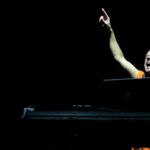The lion dance, often referred to as “the Dance Of The Lion”, is a captivating traditional Asian art form with roots stretching back 5000 years in China. More than just a performance, it’s a vibrant cultural spectacle where skilled performers embody the spirit of the lion, mimicking its movements within an elaborate costume. This dynamic display is not merely for entertainment; it’s a symbolic ritual believed to usher in good luck and prosperity for all who witness it. Each lion in this mesmerizing dance comes to life through the synchronized efforts of two individuals. One dancer, the soul of the head, dictates the lion’s expressive gestures, while the other, embodying the tail, mirrors and extends these movements with precise footwork. Driving the performance is the drum, the rhythmic “heartbeat of the lion,” setting the pace and mood, harmonizing with the clashing cymbals and resonant gong that amplify the excitement and drama. While most famously associated with the jubilant Lunar New Year festivities, the dance of the lion also graces a variety of auspicious occasions, from weddings and business grand openings to school fairs and community celebrations, spreading joy and positive energy.
A typical performance unfolds as a narrative, often depicting one or a pair of lions bravely navigating obstacles to seize a symbolic prize, frequently lettuce or scrolls, representing good fortune. These challenges can manifest as representations of danger, such as menacing snakes and spiders, or formidable natural barriers like treacherous caves and rivers, all brought to life through creative props. Sometimes, the lion might even encounter a playful, adversarial Buddha character, adding a layer of interaction and jest to the spectacle. The highlight of many lion dances is the cai qing (采青), which translates to “plucking the greens.” This act is deeply symbolic, as cai qing is also a homophone for “spreading good fortune” (财青). Thus, when the lion triumphantly “plucks” the lettuce and playfully tosses it into the audience, it’s a potent gesture of sharing prosperity and blessings with everyone present.
Unraveling the Origins of the Lion Dance
The precise origins of the dance of the lion remain shrouded in folklore, with various captivating tales attempting to explain its beginnings. One particularly enchanting story takes us back to a peaceful village nestled in the mountains of Southern China, long, long ago:
A village once flourished in tranquility near the towering mountains of Southern China. However, their peace was disrupted annually by a fearsome monster with a single eye and horn. This beast would descend from its mountain lair, terrorizing the villagers and devouring their precious crops. Its terrifying roar sounded like “Nian,” and so it became known as Nian Shou (年獸), the “yearly beast” in Chinese.
Initially, the villagers felt helpless against the monstrous Nian. Despair began to set in until a wise traveling shaman arrived, bringing a spark of hope. He revealed the monster’s weaknesses: it was terrified by loud noises, the blazing glow of fire, and the bold color red. Empowered by this newfound knowledge, the villagers ingeniously crafted a fearsome animal costume from bamboo and cloth, designed to be operated by two people. They prepared for the next year’s arrival of Nian, arming themselves not just with the costume, but also with firecrackers and anything they could bang loudly – pots, pans, and metal utensils.
When the dreaded Nian reappeared the following year, the villagers were ready. The two performers in the newly made lion costume bravely rushed forward, accompanied by the entire village creating a deafening cacophony, banging on pots and pans and setting off firecrackers. The overwhelming noise and spectacle successfully scared away the Nian monster, liberating the village from its annual terror. To forever commemorate this triumphant victory and ensure continued protection, the villagers established the Lion Dance performance as an annual tradition for every New Year, a vibrant celebration of courage and community spirit.
The Rhythmic Heartbeat and Movements of the Lion Dance
Within a lion dance performance, the drum is not just a musical instrument; it is the guiding force for the lion’s every move, dictating the rhythm and pace of the narrative. The lion dancers are attuned to the drum’s intricate patterns, responding with specific steps and gestures that propel the story forward. These movements are far from random; they are a carefully choreographed vocabulary of actions, each conveying specific emotions or actions within the unfolding drama. From playful leaps and curious head tilts to powerful stances and dramatic retreats, the “dance of the lion” is a rich language expressed through motion, perfectly synchronized with the compelling rhythms of the drum, creating a performance that is both visually stunning and deeply engaging.

